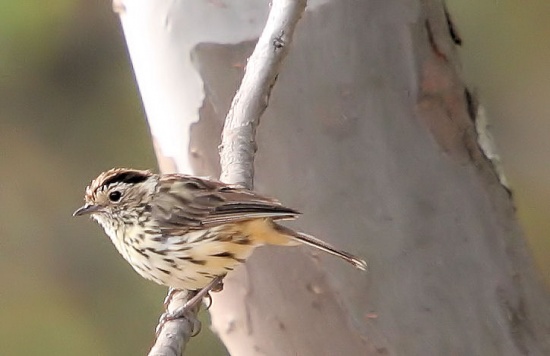m |
(range, reference) |
||
| Line 4: | Line 4: | ||
13cm. Grey brown back, wings and tail, with soft dark streaks. Black crown streaked with buff, pale, heavily streaked underparts, off-white face with streaking on the ear coverts. The male has a black upper margin to the brow, while the female has a rufous upper edge to the brow. Dark tail with a wide black band above white tips of the outer tail feathers. | 13cm. Grey brown back, wings and tail, with soft dark streaks. Black crown streaked with buff, pale, heavily streaked underparts, off-white face with streaking on the ear coverts. The male has a black upper margin to the brow, while the female has a rufous upper edge to the brow. Dark tail with a wide black band above white tips of the outer tail feathers. | ||
==Distribution== | ==Distribution== | ||
| − | [[Australia]]. | + | Central and eastern [[Queensland]] through [[New South Wales]] to east and central [[Victoria]], [[Australia]]. |
==Taxonomy== | ==Taxonomy== | ||
| − | + | This species is monotypic.<sup>[[#References|[1]]]</sup> <br> | |
Formerly this species was placed in its own genus ''Chthonicola''. Now it's considered to belong to the genus ''Pyrrholaemus''. | Formerly this species was placed in its own genus ''Chthonicola''. Now it's considered to belong to the genus ''Pyrrholaemus''. | ||
==Habitat== | ==Habitat== | ||
| Line 15: | Line 15: | ||
It builds a rounded, domed, nest, with a side entrance, of dry grass and strips of bark which is located in a slight hollow in the ground or the base of a low thick plant. 3-4 glossy red-brown eggs are laid, both parents feed the nestlings. | It builds a rounded, domed, nest, with a side entrance, of dry grass and strips of bark which is located in a slight hollow in the ground or the base of a low thick plant. 3-4 glossy red-brown eggs are laid, both parents feed the nestlings. | ||
| − | + | ==References== | |
| + | #{{Ref-Clements6thDec08}} | ||
| + | {{Ref}} | ||
==External Links== | ==External Links== | ||
{{GSearch|Pyrrholaemus+sagittatus}} | {{GSearch|Pyrrholaemus+sagittatus}} | ||
*[http://www.aviceda.org/abid/birdimages.php?action=birdspecies&fid=64&bid=1007 View more images of this species on the ABID] | *[http://www.aviceda.org/abid/birdimages.php?action=birdspecies&fid=64&bid=1007 View more images of this species on the ABID] | ||
[[Category:Birds]][[category:incomplete]] [[Category:Pyrrholaemus]] | [[Category:Birds]][[category:incomplete]] [[Category:Pyrrholaemus]] | ||
Revision as of 15:19, 9 November 2009
- Pyrrholaemus sagittatus
Identification
13cm. Grey brown back, wings and tail, with soft dark streaks. Black crown streaked with buff, pale, heavily streaked underparts, off-white face with streaking on the ear coverts. The male has a black upper margin to the brow, while the female has a rufous upper edge to the brow. Dark tail with a wide black band above white tips of the outer tail feathers.
Distribution
Central and eastern Queensland through New South Wales to east and central Victoria, Australia.
Taxonomy
This species is monotypic.[1]
Formerly this species was placed in its own genus Chthonicola. Now it's considered to belong to the genus Pyrrholaemus.
Habitat
Eucalyptus, grassy understorey, rocky ridges or in gullies, native tussock grasses, a sparse shrub layer, and an open canopy.
Behaviour
The diet includes seeds and insects.
It builds a rounded, domed, nest, with a side entrance, of dry grass and strips of bark which is located in a slight hollow in the ground or the base of a low thick plant. 3-4 glossy red-brown eggs are laid, both parents feed the nestlings.
References
- Clements, JF. 2008. The Clements Checklist of Birds of the World. 6th ed., with updates to December 2008. Ithaca: Cornell Univ. Press. ISBN 978-0801445019.
Recommended Citation
- BirdForum Opus contributors. (2025) Speckled Warbler. In: BirdForum, the forum for wild birds and birding. Retrieved 5 January 2025 from https://www.birdforum.net/opus/Speckled_Warbler




